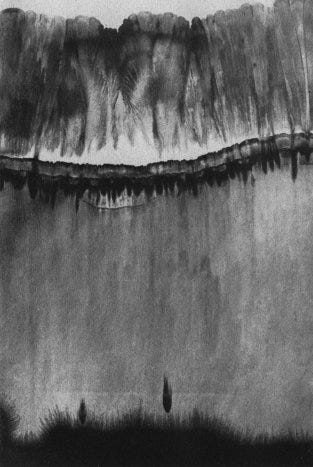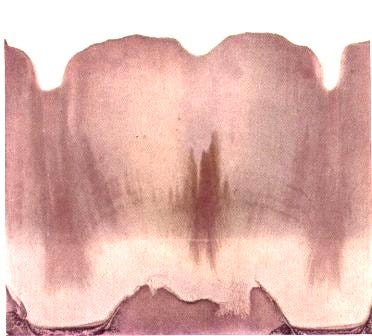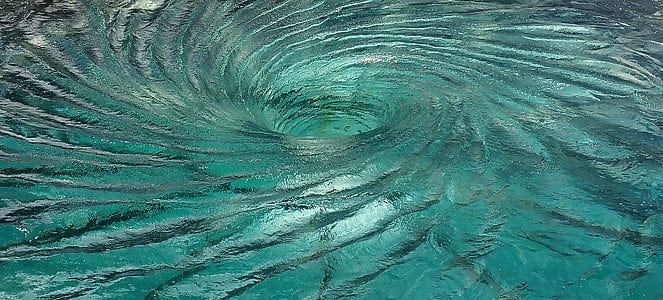Planetary Dynamics and Metal Salts: The Discoveries of Lili Kolisko
Harmonic Biology: Exploring the Impact of Subtle Forces on Life - Volume II
Disclaimer: We feel it is imperative to note that we here at Arkadia Vitalis believe that while mainstream scientific consensus models can offer useful heuristics, they may not accurately reflect underlying reality and could potentially be altogether incorrect. We remain agnostic to the degree of reality representation that exists within modern biology, chemistry, physics, and all of the other so-called hard sciences. Reference to hypotheses, models, studies, and otherwise in these explorations should not be construed as endorsement.
Lili Kolisko
As we continue our journey with Arkadia Vitalis in the series Harmonic Biology: Exploring the Impact of Subtle Forces on Life, we delve deeper into the intricate dance between cosmic forces and earthly substances. Building upon the foundation laid by Giorgio Piccardi's work on cosmic influences on chemical reactions [1], we now turn to Lili Kolisko (1889-1976), whose pioneering research at the Biological Institute of the Goetheanum opened new vistas in understanding the subtle interplay between celestial phenomena and terrestrial matter. Her meticulous experiments and observations offer a unique perspective on the interconnectedness of the cosmos and life on Earth, inviting us to reconsider our place in the universe and the forces that shape our existence.
The Essence of Kolisko’s Work
Lili Kolisko's work represents a bold attempt to bridge the gap between the material and the spiritual, to unveil what she termed "the Mystery of Matter." Her experiments, inspired by the anthroposophical teachings of Rudolf Steiner, sought to demonstrate that stars and planets exert real, measurable influences on earthly substances [2]. This approach was revolutionary for its time, challenging the prevailing mechanistic worldview of early 20th-century science. Kolisko's work was not merely an academic exercise; it was a passionate quest to reveal the hidden connections between the cosmic and the terrestrial, the macro and the microcosm. Her dedication to this pursuit led her to develop novel experimental techniques that combined scientific rigor with an openness to phenomena that lay beyond the conventional boundaries of scientific inquiry.
Kolisko's approach was both scientific and artistic. She observed that when substances enter a liquid state, they become subject not only to earthly forces but also to planetary influences. This fundamental insight guided her experimental work with metal salts, particularly those of iron, silver, and lead, which she associated with Mars, the Moon, and Saturn respectively, following Steiner's indications [2]. Her method of observation was unique, blending quantitative measurement with qualitative assessment, allowing her to perceive patterns and relationships that might have been overlooked by more conventional scientific approaches. This holistic methodology allowed Kolisko to bridge the gap between objective scientific observation and subjective artistic interpretation, creating a new paradigm for understanding the subtle influences at work in nature.
Kolisko’s Experimental Method
Kolisko's method was deceptively simple yet profoundly revealing. She dissolved metal salts in distilled water and allowed the solutions to rise on filter paper, creating patterns that she meticulously observed and photographed. The resulting "pictures," as she called them, showed remarkable variations depending on the time of day, celestial events, and combinations of metals used [2]. This technique, known as capillary dynamolysis, was a novel approach that allowed for the visualization of subtle forces at work in the solutions. Kolisko's attention to detail was extraordinary; she would often spend hours observing the formation of these patterns, noting even the slightest variations in color, form, and texture. Her work required not only scientific precision but also a keen artistic sensibility, as she sought to interpret the meaning behind the intricate forms that emerged on the filter paper.
Key Experiments
Day and Night Variations: Kolisko observed that patterns formed by silver and iron solutions differed significantly between day and night, with night patterns showing greater complexity and variety of forms [2]. These experiments were repeated numerous times over several years, establishing a consistent pattern of diurnal variation. The night patterns often exhibited more intricate, lace-like structures, while day patterns tended to be more uniform and less complex. This observation led Kolisko to hypothesize about the existence of cosmic rhythms that influence terrestrial matter in ways that vary with the Earth's rotation.
Light and Darkness: She demonstrated that the differences were not merely due to light and darkness, as experiments conducted in dark rooms during the day produced different results from those conducted at night [2]. This finding was particularly significant, as it suggested that the observed variations were not simply a result of the presence or absence of light, but were influenced by some other factor related to the Earth's position relative to the cosmos. Kolisko's meticulous control of experimental conditions, including temperature and humidity, lent credibility to her assertion that these differences were due to subtle cosmic influences.
Planetary Conjunctions: During a conjunction of Sun and Saturn on November 21, 1926, Kolisko observed dramatic changes in the behavior of lead solutions, which she interpreted as evidence of cosmic influences on earthly matter [2]. This experiment was particularly striking, as it showed a clear correlation between a specific astronomical event and observable changes in the behavior of a terrestrial substance. The lead solutions, which typically produced distinctive patterns, showed a marked reduction in form-creating activity during the conjunction, only to return to their normal behavior as the celestial event concluded. This observation provided compelling evidence for Kolisko's hypothesis about the influence of planetary positions on earthly substances.
The Solar Eclipse Experiments
Kolisko's most striking experiments were conducted during the total solar eclipse of June 29, 1927. These experiments, detailed in her work "Working With The Stars In Earthly Substances," provide compelling evidence for the influence of celestial events on earthly matter [3]. The solar eclipse offered a unique opportunity to observe how a dramatic cosmic event might affect the behavior of terrestrial substances. Kolisko approached these experiments with great anticipation, recognizing their potential to provide clear evidence of the cosmic-terrestrial connection she had long theorized. Her preparations were extensive, involving multiple experimental setups to capture the effects of the eclipse at various stages.
Gold Chloride Experiments
Kolisko observed that during the eclipse, the usual golden-yellow color of the gold chloride solution became dull, with brownish-red and dirty violet tones. The picture formed by the solution during the eclipse showed a large number of specks, unlike the clear, luminous colors seen in normal conditions [3]. This change was not subtle; it was a dramatic transformation that occurred precisely as the eclipse began and gradually reversed as the eclipse ended. Kolisko noted that the specks appeared to be a kind of fragmentation of the usual gold patterns, as if the eclipse had disrupted the coherent influence of the Sun on the gold solution. The return to normal coloration and pattern formation after the eclipse further strengthened the connection between the celestial event and the behavior of the gold chloride.
Silver Nitrate Experiments
The silver nitrate solutions showed even more dramatic changes during the eclipse. The usual orderly patterns formed by silver nitrate were disrupted, showing what Kolisko described as "chaos reigning" with different forces struggling for mastery [3]. This disruption was so pronounced that Kolisko likened it to a battlefield, with various formative forces competing to shape the patterns on the filter paper. The chaos observed in the silver nitrate patterns during the eclipse was in stark contrast to the typically harmonious and rhythmic forms produced under normal conditions. Kolisko interpreted this as evidence of the Moon's influence overshadowing that of the Sun during the eclipse, creating a temporary imbalance in the subtle forces governing the behavior of the silver solution.
Gold and Silver Combined Experiments
When Kolisko combined gold chloride and silver nitrate solutions, the results were even more striking. During normal conditions, this combination produces beautiful, intricate patterns with a wealth of colors. However, during the eclipse, the patterns became formless and the colors washed out to a greyish violet [3]. This experiment was particularly significant as it represented the interaction between substances associated with the Sun (gold) and the Moon (silver), mirroring the celestial drama of the eclipse itself. The loss of form and color in the combined solution during the eclipse seemed to reflect the temporary dominance of lunar influences over solar ones, providing a vivid illustration of how cosmic events might be mirrored in terrestrial substances.
Gold and Tin Experiments
Perhaps the most dramatic results were seen in the combination of gold chloride and tin chloride. Normally, this combination produces a purple color known as the "purple of Cassius." However, during the eclipse, the solutions barely reacted, producing a blackish hue instead of the usual purple. Kolisko interpreted this as the gold being "effaced" by the tin, mirroring the Sun being obscured by the Moon during the eclipse [3]. The lack of reaction between gold and tin during the eclipse was particularly intriguing, as it suggested not just a change in appearance, but a fundamental alteration in the chemical behavior of these substances. Kolisko observed that this effect persisted for several days after the eclipse, gradually returning to normal over the course of a week. This extended influence led her to speculate about the lasting impact of significant cosmic events on terrestrial matter.
Implications for Biological Processes
Illustration from John Flamsteed’s ‘The Celestial Atlas of Flamsteed.’
Kolisko's work suggests that subtle cosmic forces can indeed impact the behavior of metal salts, revealing deeper connections between celestial movements and terrestrial chemistry. The implications for human biology are profound, though further research is needed to establish direct links. If cosmic events can influence the behavior of simple salt solutions, it's conceivable that they might also affect the complex biochemical processes within living organisms. This possibility opens up new avenues for understanding the relationship between human health and cosmic rhythms.
For instance, the influence of subtle forces on iron, as demonstrated by Kolisko, could imply that these rhythms might affect how efficiently our bodies produce and utilize hemoglobin, potentially influencing overall energy levels and oxygenation of tissues. Given the central role of iron in oxygen transport and cellular respiration, any cosmic influence on iron behavior could have far-reaching effects on human physiology. This concept aligns with traditional beliefs about the influence of celestial bodies on human health, but provides a potential mechanism for such effects.
Similarly, if subtle forces influence the behavior of silver salts, this could have implications for various physiological processes. Silver plays a role in the immune system and has antibacterial properties. Fluctuations in its behavior due to cosmic influences could potentially affect these functions. The idea that the immune system might be influenced by cosmic rhythms is intriguing, potentially offering new insights into the timing of infections or the efficacy of treatments. Kolisko's work invites us to consider how the ebb and flow of cosmic influences might be reflected in the rhythms of our own bodies.
The Silica Process in Nature
Kolisko's work on the influence of cosmic forces on earthly substances can be better understood in the context of the silica process in nature. Silica, or silicon dioxide (SiO2), plays a crucial role in the Earth's crust, making up about 59% of its mass [4]. It's found in various forms, from beautifully formed quartz crystals to amorphous varieties like opal. The ubiquity of silica in the Earth's crust suggests that it may play a fundamental role in mediating between cosmic and terrestrial forces, a concept that aligns with Kolisko's observations about the sensitivity of earthly substances to cosmic influences.
Silica's ubiquity in nature extends beyond the mineral world. It's present in plants, particularly in grasses and horsetails, and in the animal kingdom, forming the skeletons of radiolarians and the structures of butterfly wings and bird feathers. Even in the human body, silica is found in hair, nails, cartilages, and various organs [4]. This widespread presence of silica across different forms of life suggests that it may play a crucial role in the organization and structuring of living matter. Kolisko's work invites us to consider whether the silica in living organisms might serve as a kind of antenna for cosmic influences, helping to attune biological processes to celestial rhythms.
Kolisko's experiments with metal salts and their interactions with cosmic forces align with the idea that silica might serve as a kind of mediator between cosmic influences and earthly life. This perspective offers a new way to understand the role of this abundant element in biological processes. If silica does indeed act as a mediator of cosmic forces, it could help explain the sensitivity of living organisms to subtle environmental changes and celestial events. This concept opens up new avenues for research into the relationship between environmental silica, cosmic rhythms, and biological health.
Light, Darkness, and Plant Growth
Kolisko's research also touched upon the fundamental interplay between light and darkness in plant growth, a theme that resonates with her work on cosmic influences. Her experiments revealed fascinating patterns in how plants respond to varying light conditions [4]. These studies not only provided insights into plant physiology but also offered a model for understanding how living organisms integrate and respond to cosmic rhythms. The rhythmic alternation of light and darkness is one of the most fundamental cosmic influences on terrestrial life, and Kolisko's work helped to elucidate the subtle ways in which this rhythm shapes plant development.
In daylight experiments conducted throughout a year, Kolisko observed that during the "dark" months (January, February, December), the first leaf of wheat plants was longer than the second. In contrast, for the rest of the year, the second leaf was longer. This pattern mirrors the natural fluctuation of light throughout the seasons [4]. The fact that plants exhibited this rhythmic change in growth patterns throughout the year suggested to Kolisko that they were responding not just to immediate light conditions, but to a broader cosmic rhythm. This observation aligned with her belief that living organisms are intimately connected to and influenced by celestial cycles.
When Kolisko intensified the light using electric bulbs, she found that the difference between the first and second leaf increased dramatically. Under normal daylight, the difference was 3.3 cm, but under intense electric light, it increased to 11.0 cm. This led her to propose that the difference between the first and second leaf could be an indicator of the amount of light influence on the plant [4]. The plants' dramatic response to increased light intensity demonstrated their sensitivity to changes in their light environment. Kolisko interpreted this as evidence of the plants' ability to integrate and respond to cosmic influences, with light serving as a medium for these influences. Her work in this area laid the groundwork for further investigations into the relationship between light, plant growth, and cosmic rhythms.
These findings align with later scientific studies that revealed lunar and weekly rhythmicities in plant water uptake. In 1973, Frank A. Brown and Chun S. Chow published a landmark paper demonstrating that bean seeds absorbed water at significantly different rates depending on the lunar phase, with up to 20% variation across the synodic month. They even detected a secondary 7-day rhythm, hinting at circaseptan biological cycles [6]. Similarly, Spruyt et al. (1987) observed both monthly and weekly cycles in seed imbibition, reinforcing the idea that biological processes like germination are subtly synchronized with cosmic and temporal rhythms [7]. These empirical findings from mainstream scientific journals lend compelling support to Kolisko’s earlier assertions regarding plant sensitivity to lunar cycles.
Kolisko's Challenge to the Modern World
Kolisko's groundbreaking experiments challenge us to reconsider the profound influences that seemingly subtle forces such as electromagnetic radiation and cosmic activity exert on our physical bodies and overall health. By acknowledging the influence of these cosmic perturbations on our biological systems, we open the door to a deeper, more integrated approach to health and well-being. Her work invites us to expand our understanding of the factors that influence health, moving beyond a purely materialistic view to consider the role of subtle, cosmic influences. This perspective has potential implications for fields ranging from chronobiology to integrative medicine.
Kolisko interpreted her findings as evidence that the physical realm is deeply interconnected with the cosmic and spiritual realms. She believed that the patterns she observed in her experiments were manifestations of the spiritual forces at work in the material world. This perspective aligns with the anthroposophical view that all physical phenomena are imbued with spiritual significance, a view that Kolisko, as a student of Rudolf Steiner (1861-1925), deeply embraced [4]. While this interpretation may be controversial in mainstream scientific circles, it offers a unique perspective on the nature of reality and the interconnectedness of all things. Kolisko's work challenges us to consider how spiritual or metaphysical concepts might be integrated with scientific inquiry to provide a more comprehensive understanding of the world.
Her interpretations suggest that the health of an organism is influenced not just by material factors such as diet and environment, but also by the spiritual and cosmic forces that permeate the universe. Kolisko's work implies that achieving and maintaining health requires harmony with these broader cosmic rhythms. This holistic view of health aligns with many traditional healing systems that emphasize the importance of living in harmony with natural cycles. It also resonates with modern research into chronobiology and the impact of circadian rhythms on health. Kolisko's work thus provides a bridge between ancient wisdom and modern scientific inquiry, offering new avenues for exploring the complex factors that contribute to health and well-being.
The Rhythmic Nature of Cosmic Influences
One of the most significant aspects of Kolisko's work was her observation of the rhythmic nature of cosmic influences on earthly substances. Her experiments revealed that the effects of celestial events were not constant, but rather ebbed and flowed in a rhythmic manner. This was particularly evident in her studies of the aftermath of the solar eclipse, where she observed that the disrupted patterns in metal salt solutions gradually returned to normal over the course of several days [3].
Modern statistical reanalysis has validated Kolisko’s early findings. In 2014, Zürcher and Schlaepfer re-examined historical data on European spruce seed germination and tree physiology. Their study confirmed subtle but statistically significant rhythmicities tied to the lunar cycle [8]. The researchers explicitly acknowledged the coherence of their results with Kolisko’s work, suggesting that her observations were not anomalous but early indicators of a real and measurable phenomenon. This modern confirmation bridges the historical and contemporary, reinforcing the validity of lunar rhythmicities in living systems.
This concept of cosmic rhythms influencing terrestrial processes aligns with many traditional systems of knowledge, from ancient astronomical calendars to agricultural practices based on lunar cycles. Kolisko's work provided a scientific framework for understanding these age-old observations, suggesting that the rhythms observed in celestial movements might have tangible effects on earthly matter. Her findings invite us to consider how these cosmic rhythms might influence biological processes, from the cellular level to the functioning of entire ecosystems.
The implications of this rhythmic influence extend beyond the realm of basic science. In the field of medicine, for instance, it raises questions about the timing of treatments and the potential for optimizing therapeutic interventions based on cosmic cycles. In agriculture, it suggests new avenues for understanding and potentially enhancing crop growth and health. Kolisko's work thus opens up a vast field of potential research and application, challenging us to develop new methods for detecting and working with these subtle cosmic influences.
Connecting Kolisko's Work to Modern Research: The Fourth Phase of Water
While Lili Kolisko's work may seem esoteric to some modern scientists, her investigations into the subtle influences on liquid substances find interesting parallels in contemporary research, particularly in the work of Dr. Gerald Pollack on the "fourth phase" of water [5].
Pollack's research has revealed that water adjacent to hydrophilic surfaces forms a structured layer he calls "exclusion zone" (EZ) water. This EZ water has properties distinct from bulk water, including a negative electrical charge, increased viscosity, and the ability to exclude solutes [5]. Interestingly, Pollack has found that this structured water is sensitive to light and other electromagnetic influences, exhibiting changes in its properties based on exposure to different wavelengths of light and other environmental factors.
This sensitivity of structured water to environmental influences resonates with Kolisko's observations of how metal salt solutions responded to cosmic events. While Kolisko attributed these changes to planetary influences, Pollack's work provides a potential physical mechanism for how subtle environmental factors might affect the behavior of aqueous solutions.
For instance, Kolisko's observations of how gold and silver solutions changed their behavior during a solar eclipse [3] could potentially be explained by changes in the structuring of water molecules around the metal ions. The eclipse, by altering the light reaching the Earth, might have influenced the formation or stability of EZ water in Kolisko's solutions, leading to the observed changes in pattern formation.
Moreover, Pollack's finding that infrared light is particularly effective at expanding the EZ [5] aligns with Kolisko's emphasis on the importance of warmth and light in her experiments. Kolisko often noted the significance of temperature and lighting conditions in her studies, which in light of Pollack's work, might be understood as factors influencing the structuring of water in her solutions.
The connection between Kolisko and Pollack's work extends to potential biological implications as well. Pollack suggests that the properties of EZ water may play crucial roles in cellular function, from maintaining cell structure to driving cellular processes [5]. This idea echoes Kolisko's belief in the importance of cosmic influences on biological processes, mediated through their effects on substances like water.
While the exact mechanisms linking cosmic events to changes in liquid behavior remain to be elucidated, the parallels between Kolisko's observations and Pollack's findings on structured water offer intriguing possibilities for future research. They suggest that Kolisko may have been observing phenomena related to the structuring of water, influenced by subtle environmental factors including light, electromagnetic fields, and potentially other, yet-to-be-understood cosmic influences.
This connection not only provides a potential bridge between Kolisko's work and modern biophysics but also underscores the importance of remaining open to unexpected influences on physical and biological systems. As our understanding of water's complex behavior continues to evolve, Kolisko's pioneering work may find new relevance, inspiring further investigations into the subtle interplay between cosmic forces and terrestrial matter.
Until Next Time
Kolisko's work reminds us of the importance of remaining open to new perspectives and considering the potential influence of factors beyond our immediate understanding. Her research suggests that the health and behavior of living organisms may be influenced by a complex interplay of earthly and cosmic forces, opening up new avenues for holistic approaches to health and wellbeing.
As we move forward in our exploration, we find ourselves at the threshold of contemporary research that builds upon and extends Kolisko's insights. In our next essay, we will delve into the work of physicist Gopi Krishna Vijaya, whose investigations into atomism and homeopathy offer a fresh perspective on the nature of matter and energy.
As we continue our journey through this series of interconnected explorations, we invite readers to approach these ideas with an open mind, recognizing that the frontiers of scientific understanding often lie at the boundaries between established disciplines. The work of researchers like Kolisko and Vijaya challenges us to expand our conceptual frameworks and consider the profound implications of cosmic influences on our health, our environment, and our place in the universe.
References
[1] G. Piccardi, The Chemical Basis for Medical Climatology, Springfield, IL, USA: Charles C Thomas, 1962.
[2] L. Kolisko, "Workings of the Stars in Earthly Substances", Kolisko Archive Publications, 1928.
[3] L. Kolisko, "Working With The Stars In Earthly Substances: The Solar Eclipse, June 29th, 1927", Orient-Occident Verlag, Stuttgart-Den Haag-London, 1928.
[4] E. Kolisko and L. Kolisko, "Agriculture of Tomorrow," Kolisko Archive Publications, 1978.
[5] G. H. Pollack, "The Fourth Phase of Water: Beyond Solid, Liquid, and Vapor," Ebner and Sons Publishers, 2013.
[6] Brown, F. A., & Chow, C. S. (1973). “Lunar-correlated variations in water uptake by bean seeds.” Biological Bulletin, 145(2), 265–278.
[7] Spruyt, E., Verbelen, J.-P., & De Greef, J. (1987). “Expression of Circaseptan and Circannual Rhythmicity in the Imbibition of Dry-Stored Bean Seeds.” Plant Physiology, 84(3), 707–710.
[8] Zürcher, E., & Schlaepfer, R. (2014). “Lunar Rhythmicities in the Biology of Trees, Especially in the Germination of European Spruce.” Journal of Plant Studies, 3(1), 103–113.
















